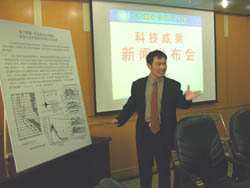
Prof. Ni Sidao from the University of Science and Technology of China.

The Dec. 26, 2004 earthquake under the Indian Ocean floor triggered an outbreak of devastating tsunami, leading to incredible damage and tragic loss of life in littoral countries. Records showed that the killer tsunami reached the seaside Indonesian islands after half an hour, and within several hours it reached the beach lands of Sri Lanka, Thailand and other countries at the rim of the Ocean.
While earthquakes are somewhat unpredictable, and always beyond our control, according to experts, earthquake related tsunamis can be measured and predicted in time to release alert to residents of susceptible coastal areas. If an early warning system had been available in the Indian Ocean region, they believe, the casualties and losses would have been greatly mitigated.
In collaboration with US colleagues, Prof. Ni Sidao from the University of Science and Technology of China, a CAS affiliate, works out a rapid method to assess the seismic hazard in the immediate future by analyzing the high-frequency seismic signals. As reported in the March 31 issue of the journal
Nature, the algorithm could determine the earthquake's rupture length, duration and other fundamental parameters for earthquake with magnitude 9 and above within 25 minutes so that an early warning may be issued.
The tsunami is often caused by underwater earthquakes, which usually radiate such seismic waves as the P-wave and S-wave. Through reactions with the earth surface and interior velocity structure, surface waves and secondary body waves (such as PP, PPP and SS) are formed. A big quake also excites the earth's free oscillation at a very low frequency. In different frequency ranges, the seismic waves have different strengths and travel at different speeds. P-waves, which always arrive first, play a critical role in determining the earthquake's basic parameters. A conventional approach is to invert the rupture process with low-frequency P-waves (less than 0.5 HZ). In the case of a mega quake, the P-wave would always be contaminated by the signals of PP and other secondary waves so that the basic parameters cannot be determined immediately. More time will be needed if using data from surface waves or the free oscillation.
As described in the paper titled "Energy radiation from the Sumatra earthquake," Prof. Ni and his US co-workers from the California Institute of Technology have succeeded in analyzing the inter-relations between the length of the seismic wave and its amplitude by using the high-frequency signals carried by the P-wave (above 2 HZ, where signals from PP, PPP and S waves are very weak) from the massive Sumatra-Andaman earthquake on December 26, 2004. The scientists were able to rapidly define the directivity of the rupture caused by the earthquake. In this way, they discovered the rupture length was longer than 1,200 kilometers and the earthquake's duration was more than 500 seconds, substantially longer than those of the great Chilean quake in 1960. This method is found particularly applicable to great earthquakes, since it is suitable for scrutinizing powerful earthquakes higher than Mw 9 (moment magnitude). In addition, it is capable of determining the key seismic parameters within 25 minutes. By providing the timely key data to a tsunami-simulator, the approach can send out an early warning before the arrival of a catastrophic tsunami and hence massive casualties and economic losses may be avoided.
Ni et al.'s work is mirrored by Seth Stein and Emile Okal, both from Northwest University, based in Illinois, US, in another research paper published in the same issue of Nature. He hopes to further cooperate with the United States Geological Survey in data sharing and methodology discussion. "If global cooperation runs smoothly," Ni said, "we could realize effective early warning for big tsunamis caused by Magnitude 9 and above earthquakes in two years, with sound reliability."








